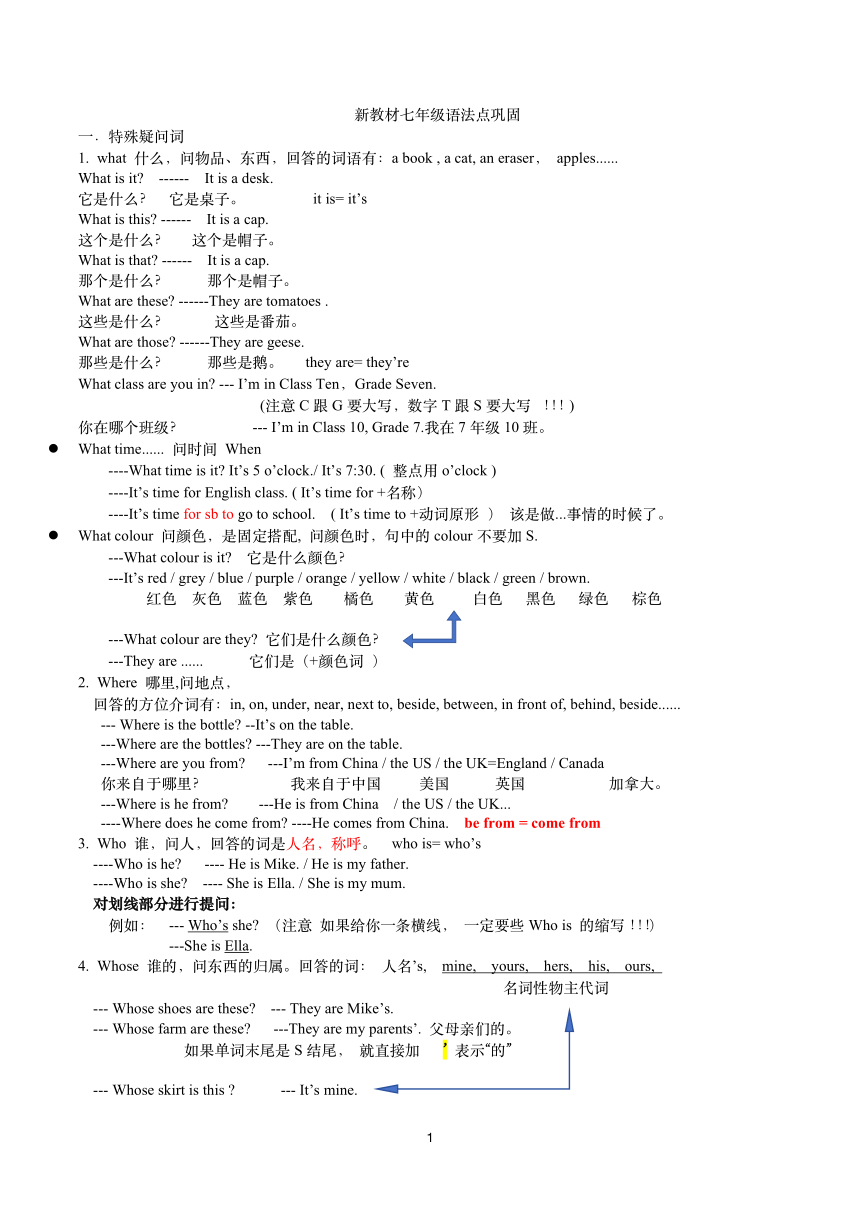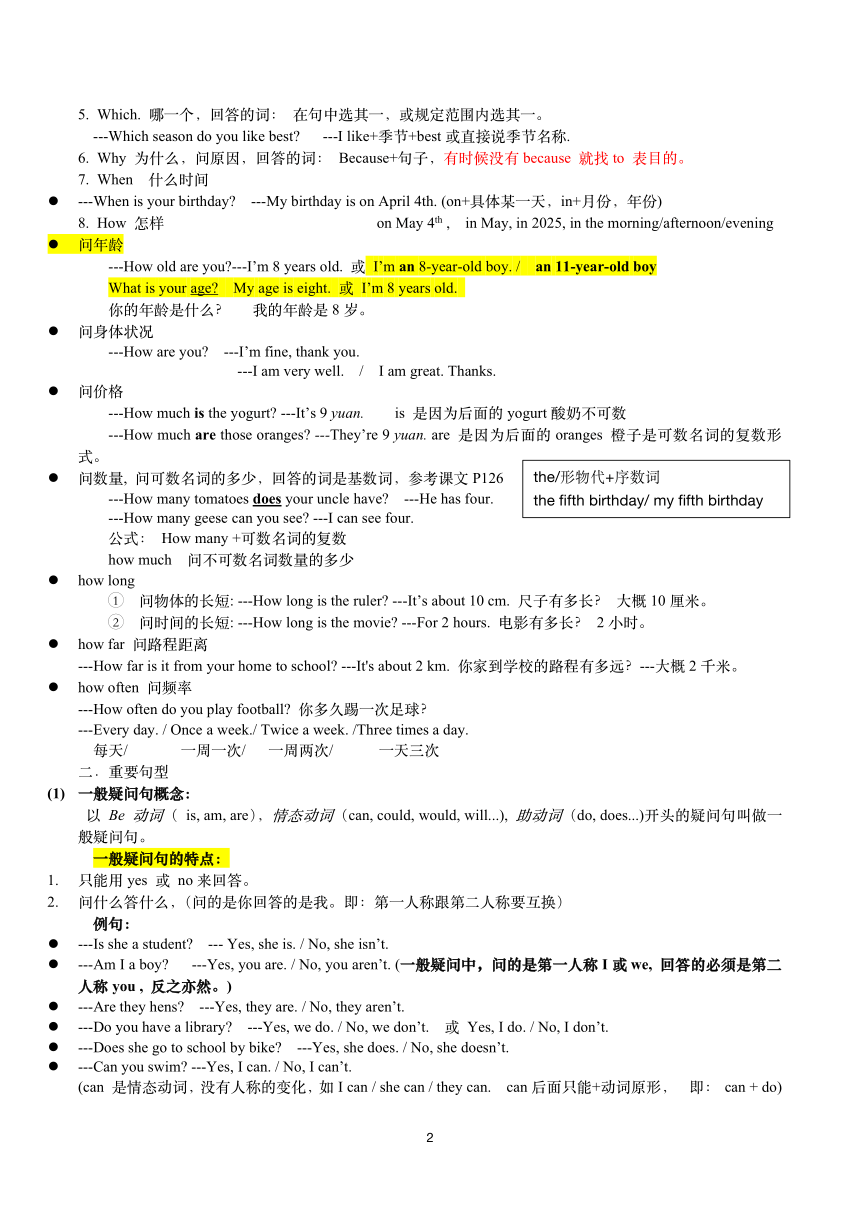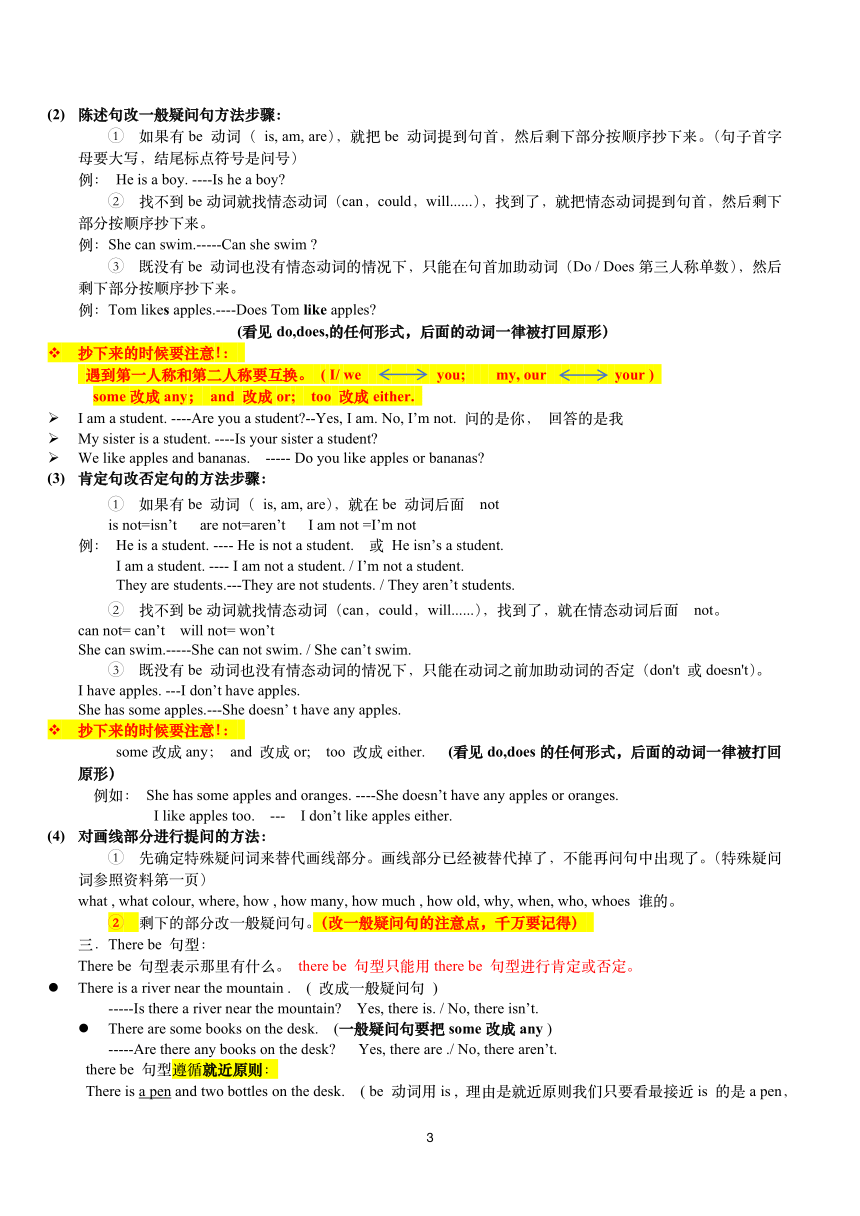 資源簡(jiǎn)介
資源簡(jiǎn)介
新教材七年級(jí)語(yǔ)法點(diǎn)鞏固
一.特殊疑問(wèn)詞
1. what 什么,問(wèn)物品、東西,回答的詞語(yǔ)有:a book , a cat, an eraser, apples......
What is it ------ It is a desk.
它是什么? 它是桌子。 it is= it’s
What is this ------ It is a cap.
這個(gè)是什么? 這個(gè)是帽子。
What is that ------ It is a cap.
那個(gè)是什么? 那個(gè)是帽子。
What are these ------They are tomatoes .
這些是什么? 這些是番茄。
What are those ------They are geese.
那些是什么? 那些是鵝。 they are= they’re
What class are you in --- I’m in Class Ten,Grade Seven.
(注意 C跟 G要大寫,數(shù)字 T跟 S要大寫 !!!)
你在哪個(gè)班級(jí)? --- I’m in Class 10, Grade 7.我在 7年級(jí) 10班。
What time...... 問(wèn)時(shí)間 When
----What time is it It’s 5 o’clock./ It’s 7:30. ( 整點(diǎn)用 o’clock )
----It’s time for English class. ( It’s time for +名稱)
----It’s time for sb to go to school. ( It’s time to +動(dòng)詞原形 ) 該是做...事情的時(shí)候了。
What colour 問(wèn)顏色,是固定搭配, 問(wèn)顏色時(shí),句中的 colour不要加 S.
---What colour is it 它是什么顏色?
---It’s red / grey / blue / purple / orange / yellow / white / black / green / brown.
紅色 灰色 藍(lán)色 紫色 橘色 黃色 白色 黑色 綠色 棕色
---What colour are they 它們是什么顏色?
---They are ...... 它們是(+顏色詞 )
2. Where 哪里,問(wèn)地點(diǎn),
回答的方位介詞有:in, on, under, near, next to, beside, between, in front of, behind, beside......
--- Where is the bottle --It’s on the table.
---Where are the bottles ---They are on the table.
---Where are you from ---I’m from China / the US / the UK=England / Canada
你來(lái)自于哪里? 我來(lái)自于中國(guó) 美國(guó) 英國(guó) 加拿大。
---Where is he from ---He is from China / the US / the UK...
----Where does he come from ----He comes from China. be from = come from
3. Who 誰(shuí),問(wèn)人,回答的詞是人名,稱呼。 who is= who’s
----Who is he ---- He is Mike. / He is my father.
----Who is she ---- She is Ella. / She is my mum.
對(duì)劃線部分進(jìn)行提問(wèn):
例如: --- Who’s she (注意 如果給你一條橫線, 一定要些Who is 的縮寫!!!)
---She is Ella.
4. Whose 誰(shuí)的,問(wèn)東西的歸屬。回答的詞: 人名’s, mine, yours, hers, his, ours,
名詞性物主代詞
--- Whose shoes are these --- They are Mike’s.
--- Whose farm are these ---They are my parents’. 父母親們的。
如果單詞末尾是 S結(jié)尾, 就直接加 ’ 表示“的”
--- Whose skirt is this --- It’s mine.
1
5. Which. 哪一個(gè),回答的詞: 在句中選其一,或規(guī)定范圍內(nèi)選其一。
---Which season do you like best ---I like+季節(jié)+best或直接說(shuō)季節(jié)名稱.
6. Why 為什么,問(wèn)原因,回答的詞: Because+句子,有時(shí)候沒有 because 就找 to 表目的。
7. When 什么時(shí)間
---When is your birthday ---My birthday is on April 4th. (on+具體某一天,in+月份,年份)
8. How 怎樣 on May 4th , in May, in 2025, in the morning/afternoon/evening
問(wèn)年齡
---How old are you ---I’m 8 years old. 或 I’m an 8-year-old boy. / an 11-year-old boy
What is your age My age is eight. 或 I’m 8 years old.
你的年齡是什么? 我的年齡是 8歲。
問(wèn)身體狀況
---How are you ---I’m fine, thank you.
---I am very well. / I am great. Thanks.
問(wèn)價(jià)格
---How much is the yogurt ---It’s 9 yuan. is 是因?yàn)楹竺娴?yogurt酸奶不可數(shù)
---How much are those oranges ---They’re 9 yuan. are 是因?yàn)楹竺娴?oranges 橙子是可數(shù)名詞的復(fù)數(shù)形
式。
問(wèn)數(shù)量, 問(wèn)可數(shù)名詞的多少,回答的詞是基數(shù)詞,參考課文 P126 the/形物代+序數(shù)詞
---How many tomatoes does your uncle have ---He has four. the fifth birthday/ my fifth birthday
---How many geese can you see ---I can see four.
公式: How many +可數(shù)名詞的復(fù)數(shù)
how much 問(wèn)不可數(shù)名詞數(shù)量的多少
how long
1 問(wèn)物體的長(zhǎng)短: ---How long is the ruler ---It’s about 10 cm. 尺子有多長(zhǎng)? 大概 10厘米。
2 問(wèn)時(shí)間的長(zhǎng)短: ---How long is the movie ---For 2 hours. 電影有多長(zhǎng)? 2小時(shí)。
how far 問(wèn)路程距離
---How far is it from your home to school ---It's about 2 km. 你家到學(xué)校的路程有多遠(yuǎn)?---大概 2千米。
how often 問(wèn)頻率
---How often do you play football 你多久踢一次足球?
---Every day. / Once a week./ Twice a week. /Three times a day.
每天/ 一周一次/ 一周兩次/ 一天三次
二.重要句型
(1) 一般疑問(wèn)句概念:
以 Be 動(dòng)詞( is, am, are),情態(tài)動(dòng)詞(can, could, would, will...), 助動(dòng)詞(do, does...)開頭的疑問(wèn)句叫做一
般疑問(wèn)句。
一般疑問(wèn)句的特點(diǎn):
1. 只能用 yes 或 no來(lái)回答。
2. 問(wèn)什么答什么,(問(wèn)的是你回答的是我。即:第一人稱跟第二人稱要互換)
例句:
---Is she a student --- Yes, she is. / No, she isn’t.
---Am I a boy ---Yes, you are. / No, you aren’t. (一般疑問(wèn)中,問(wèn)的是第一人稱 I或 we, 回答的必須是第二
人稱 you , 反之亦然。)
---Are they hens ---Yes, they are. / No, they aren’t.
---Do you have a library ---Yes, we do. / No, we don’t. 或 Yes, I do. / No, I don’t.
---Does she go to school by bike ---Yes, she does. / No, she doesn’t.
---Can you swim ---Yes, I can. / No, I can’t.
(can 是情態(tài)動(dòng)詞,沒有人稱的變化,如 I can / she can / they can. can后面只能+動(dòng)詞原形, 即: can + do)
2
(2) 陳述句改一般疑問(wèn)句方法步驟:
1 如果有 be 動(dòng)詞( is, am, are),就把 be 動(dòng)詞提到句首,然后剩下部分按順序抄下來(lái)。(句子首字
母要大寫,結(jié)尾標(biāo)點(diǎn)符號(hào)是問(wèn)號(hào))
例: He is a boy. ----Is he a boy
2 找不到 be動(dòng)詞就找情態(tài)動(dòng)詞(can,could,will......),找到了,就把情態(tài)動(dòng)詞提到句首,然后剩下
部分按順序抄下來(lái)。
例:She can swim.-----Can she swim
3 既沒有 be 動(dòng)詞也沒有情態(tài)動(dòng)詞的情況下,只能在句首加助動(dòng)詞(Do / Does第三人稱單數(shù)),然后
剩下部分按順序抄下來(lái)。
例:Tom likes apples.----Does Tom like apples
(看見 do,does,的任何形式,后面的動(dòng)詞一律被打回原形)
抄下來(lái)的時(shí)候要注意!:
遇到第一人稱和第二人稱要互換。 ( I/ we you; my, our your )
some改成 any; and 改成 or; too 改成 either.
I am a student. ----Are you a student --Yes, I am. No, I’m not. 問(wèn)的是你, 回答的是我
My sister is a student. ----Is your sister a student
We like apples and bananas. ----- Do you like apples or bananas
(3) 肯定句改否定句的方法步驟:
1 如果有 be 動(dòng)詞( is, am, are),就在 be 動(dòng)詞后面 not
is not=isn’t are not=aren’t I am not =I’m not
例: He is a student. ---- He is not a student. 或 He isn’s a student.
I am a student. ---- I am not a student. / I’m not a student.
They are students.---They are not students. / They aren’t students.
2 找不到 be動(dòng)詞就找情態(tài)動(dòng)詞(can,could,will......),找到了,就在情態(tài)動(dòng)詞后面 not。
can not= can’t will not= won’t
She can swim.-----She can not swim. / She can’t swim.
3 既沒有 be 動(dòng)詞也沒有情態(tài)動(dòng)詞的情況下,只能在動(dòng)詞之前加助動(dòng)詞的否定(don't 或 doesn't)。
I have apples. ---I don’t have apples.
She has some apples.---She doesn’ t have any apples.
抄下來(lái)的時(shí)候要注意!:
some改成 any; and 改成 or; too 改成 either. (看見 do,does的任何形式,后面的動(dòng)詞一律被打回
原形)
例如: She has some apples and oranges. ----She doesn’t have any apples or oranges.
I like apples too. --- I don’t like apples either.
(4) 對(duì)畫線部分進(jìn)行提問(wèn)的方法:
1 先確定特殊疑問(wèn)詞來(lái)替代畫線部分。畫線部分已經(jīng)被替代掉了,不能再問(wèn)句中出現(xiàn)了。(特殊疑問(wèn)
詞參照資料第一頁(yè))
what , what colour, where, how , how many, how much , how old, why, when, who, whoes 誰(shuí)的。
2 剩下的部分改一般疑問(wèn)句。(改一般疑問(wèn)句的注意點(diǎn),千萬(wàn)要記得)
三.There be 句型:
There be 句型表示那里有什么。 there be 句型只能用 there be 句型進(jìn)行肯定或否定。
There is a river near the mountain . ( 改成一般疑問(wèn)句 )
-----Is there a river near the mountain Yes, there is. / No, there isn’t.
There are some books on the desk. (一般疑問(wèn)句要把 some改成 any )
-----Are there any books on the desk Yes, there are ./ No, there aren’t.
there be 句型遵循就近原則:
There is a pen and two bottles on the desk. ( be 動(dòng)詞用 is , 理由是就近原則我們只要看最接近 is 的是 a pen,
3
因?yàn)?a pen 是單數(shù),所以謂語(yǔ)動(dòng)詞用 is. 跟后面的 two bottles 無(wú)關(guān)。)
Is this/that....... ---Yes,it is. 或 No, it isn’t.
Are these/those ...... ---Yes, they are. 或 No, they aren’t.
單數(shù) 復(fù)數(shù)
this is 這個(gè) ,近指 these are 這些
that is 那個(gè) ,遠(yuǎn)指 thoes are那些
like表示喜歡,后面+動(dòng)詞 ing形式或+動(dòng)詞的 to do 形式
I like playing football. She likes swimming.
I like to paly football. She likes to swim
例如:I like apples. 或 I like an apple. 可數(shù)名詞一定要分清楚單數(shù)或復(fù)數(shù)。 可數(shù)名詞的單數(shù)前面
要 冠詞。
四.一般現(xiàn)在時(shí)態(tài)
1 一般現(xiàn)在時(shí)態(tài):表示經(jīng)常性,習(xí)慣性發(fā)生的動(dòng)作,常用于談?wù)撃橙说呐d趣愛好或生活習(xí)慣。
1. I usually go to school on foot.
2. I eat eggs for breakfast every morning.
3. She goes to school by bike ( 遇到第三人稱單數(shù),動(dòng)詞要變形,+s/es)
4. He likes apples. / He doesn’t like apples.
2 一般現(xiàn)在時(shí)態(tài):表示事物的特征或特性
1. Our school is large and clean.
2. The desk is brown.
3 一般現(xiàn)在時(shí)態(tài):表示客觀真理或規(guī)律
1. The earth goes around the sun. 地球圍繞這太陽(yáng)轉(zhuǎn)。
第一人稱: 只有 I 和 we ,這兩個(gè)單詞
第二人稱: you 只有這一個(gè)單詞 !
第三人稱: 除了 I, we, you 以外的任何名詞都是屬于第三人稱,我們只要判斷這個(gè)名詞是單數(shù)還是復(fù)
數(shù),例如 our school, my teacher, the book, apples... 做題目時(shí),遇到是第三人稱且單數(shù)的時(shí)候,動(dòng)詞要變成
三單的形式。動(dòng)詞原型變第三人稱單數(shù)的形式如下:
(1) 一般情況+S, 例如: help-helps, play-plays, like-likes, play-plays
(2) 以字母 s, x, sh, ch, o 結(jié)尾的單詞 +es, 例如 watch-wathes, go-goes. guess-guesses, teach-teaches,
wash-washes,
(3) 以輔音+y 結(jié)尾的單詞變 y 為 i, 再加-es, 例如:fly-flies, cry-cries, try-tries, study-studies
五:人稱代詞的五種形式
反身代詞
形容詞性物主代詞+ 當(dāng)我們想要用賓格
賓格 名詞 名詞性物主代詞 時(shí),不妨多思考一
主格
(介詞或動(dòng)詞 (用來(lái)修飾名詞,后 (等于形容詞性 步,如果所給的單
(做主語(yǔ),動(dòng)詞 v.之前) 詞與主語(yǔ)人稱一
之后,做賓語(yǔ)) 面沒有名詞,就沒有 物主代詞+名詞) 致,則用翻身代詞。
用形容詞的必要了) 注意前提是我們想
要用賓格的時(shí)候。
第 I me my mine myself
I like playing tennis. Let me help you. This is my pen. This pen is mine.
一 I go to school
4
人 with him.
稱 we us our ours ourselves
We study in the same Let us help you. Our class teacher is
school. Mr Gao.
you you your yours yourself
第二 This is your sisiter. yourseves
人稱
he him his his himself
she her her hers herself
it it its itself
第 Its name is Coco
三 它的名字是 CoCo.
人 they them their theirs themselves
稱 They like playing Their names are Tom
football. and Tim.
They work in the same
school.
She is a girl. This is my pen The pen is mine.
I like him.(he) I like his pen. I like myself.(I)
Tom likes her.
(she)
Tom likes
himself. (he)
I like my pen.(I)
六:可數(shù)名詞單數(shù)改復(fù)數(shù)的方法:
1. 一般情況下,+ s: pen---pens. bottle--bottles. apple--apples
toy--toys
2. 以輔音+y 結(jié)尾的單詞, 把 y改成 i ,再加 es,
family--families 家人,家庭 country--countries國(guó)家 activity--activities
3. 以 s, x, sh, ch, 結(jié)尾的單詞,末尾加 es,
peach--peaches, class--classes glass--glasses dish--dishes box--boxes
4. 以 o 結(jié)尾的單詞,有生命的加 es: tomato--tomatoes, potato--potatoes hero--heroes 英雄
無(wú)生命的加 s: photo-photos照片, radio--radios kilo-kilos
5. oo 改成 ee : goose--geese foot---feet tooth--teeth
6. 單復(fù)數(shù)同形: sheep---sheep
7. 不規(guī)則變化: child--children
七:關(guān)于人稱代詞的縮寫跟完全形式
I am = I'm I am not= I’m not
we are = We’re we are not= we aren’t
you are= you’re you are not= you aren’t
he is =he’s he is not= he isn’t
she is=she’s she is not = she isn’t
5
it is= it’s it is not= it isn’t
they are=they’re they are= they aren’t
關(guān)于 be 動(dòng)詞:(is , am, are )
我用 am , 你用 are , is 跟著他她它。
I用 am , you 用 are, is 跟著 he, she, it
具體細(xì)說(shuō) am 的用法:
I am , am只能用在一個(gè)單獨(dú) I 的前面, 如果 I前面還有人, 只能用復(fù)數(shù) are。
例如: I am a boy.
Tom and I are boys.
are 用來(lái)修飾可數(shù)名詞的復(fù)數(shù)形式
We are friends. 我們是朋友。 They are
is 用來(lái)修飾不可數(shù)名詞或者是可數(shù)名詞的單數(shù)。
She is a girl.
My favourite food is beef.
My favourite animal is cats.
Our class teacher is Mr. Gao. 我們的班主任, 這個(gè)的 our 是形容詞, is 要看前面的 class teacher, 跟前面
的形容詞 our 我們無(wú)關(guān)。
八:表示“的”的方式有三種:
1 加 ’s 或 ’ :
例如: This is Peter’s father.
She is my parents’ mother. 她是我父母的媽媽。(即她是我的 grandmother)
Lily and Lucy’s room 說(shuō)明是 Lily和 Lucy共同擁有的一個(gè)房間。
Lily和 Lucy的房間。
Lily’s and Lucy’s room 說(shuō)明是 Lily和 Lucy各有一個(gè)房間。因此后面要用復(fù)數(shù) rooms
Lily的(房間)和 Lucy的房間。
2 用形容詞性物主代詞, 參考前面五人稱代詞表格, 有例句的
例如:
This is my (我的)father. 這是我的父親。
These are their pens. 那些是他們的筆。
3 用 of 表示無(wú)生命的
例如: the colour of the desk 桌子的顏色 a photo of my family
一張照片 的 我的家庭
4 to 表示的(下面 5個(gè)的句型是老教材的考點(diǎn))
the answer to the question (問(wèn)題的答案)
答案 的 問(wèn)題
the key to the door (門的鑰匙 )
鑰匙 的 門
the secret to language learning (語(yǔ)言學(xué)習(xí)的秘密)
the way/ road to success
6
路 的 成功 成功之路
on the way to school / on the way ( ) home home 前面不加 to
路上 的 學(xué)校
九:表示“有”的有兩種表達(dá)方式
人有: have/ has (三單) I have a pen.
She has a pen.
物有: 例:
可數(shù)名詞的單數(shù) There is a gym in our school.
there is+ (別忘了冠詞) 那里有一個(gè)體育館在我們的學(xué)校。(就按照字面意思翻譯就可以
不可數(shù)名詞 了)
就近原則:There is a gym and a music hall in our school.
there are + 可數(shù)名詞的復(fù)數(shù)形式 There is some water in the bottle. 那里有一些水在瓶子里。
some + 可數(shù)或不可數(shù), 所以決定用 is There are some apples and bananas on the table. 那里有一些蘋果和
還是 are 跟 some無(wú)關(guān), 關(guān)鍵看后面跟 香蕉在桌子上。
著的名詞是什么!!!
There be句型的否定 There is not...= There isn’t...
There are not...=There aren’t ...
There aren’t any apples or bananas on the table.
注意 some 改 any and 改 or
There be句型的一般疑問(wèn)句 Is there... Yes, there is. 或 No, there isn’t.
Are there... Yes, there are. 或 No, there aren’t
Are there any apples on the table
注意 some 改 any and 改 or
十: 連詞:and,but, because, so, or...
1. and: 表并列或遞進(jìn),相當(dāng)于語(yǔ)文中的和;既...又...;不但...而且;
注意 and 連接兩個(gè)單詞,詞性時(shí)態(tài)要一致
Tom and Tim are good friends. Tom 和 Tim 是好朋友。
She goes to school and asks teacher for help.
她做了兩個(gè)動(dòng)作,1去學(xué)校;2向老師尋求幫忙。
but:但是,表示轉(zhuǎn)折。I like playing football, but I can’t play it well.
我喜歡踢足球,但我踢得不是很好。
intresting but difficult. easy and improtant
2. because: 表示因?yàn)椋?一般用Why進(jìn)行提問(wèn), 用 because 進(jìn)行提問(wèn)。
3. so 表示所以,I like playing football very much, so I play it with my friends everyday.
我喜歡踢足球, 所以我踢它 和我的朋友 每一天。
注意 beacuse 跟 so不能連用, 就是說(shuō)這兩個(gè)單詞不能出現(xiàn)在一個(gè)句子中。
例如: I like English because it is fun.= English is fun, so I like it.
4. or 表示或者。 Do you like apples or bananas 你喜歡蘋果還是香蕉?
7
十一:情態(tài)動(dòng)詞 Can
Can 有兩個(gè)特點(diǎn):
1. 無(wú)人稱變化,即主語(yǔ)人稱不管是誰(shuí),都是 can 不變。
2. can 的后面加動(dòng)詞原型;
I can swim. 我能夠游泳---Can you swim Yes, I can. / No, I can’t
She can swim. 她能夠游泳---Can she swim Yes, she can. / No, she can’t.
Tom can swim. Tom能夠游泳---Can Tom swim Yes, he can. / No, he can’t.
They can swim. 他們能夠游泳。---Can they swim Yes, they can./No, they can’t.
有 can的陳述句改一般疑問(wèn)句和否定句的改法看前面一般疑問(wèn)句和否定句的方法和步驟,寫得很清楚。
十二:如何正確的描述時(shí)間
7:40 seven forty 8點(diǎn)差 20分 twenty to enght.
7:30 seven thirty half past seven
7:20 seven twenty 7點(diǎn)過(guò) 20分 twenty past seven 7:20
twenty to seven 6:40
如圖所示, 時(shí)針≤30分
direct way: 時(shí)針 +分鐘
或 分鐘+past +時(shí)針 half past seven ---7:30 --- seven thirty
a quarter past seven ---7:15--seven fifteen
a quarter to seven----6:45---six forty-five
8
語(yǔ)法填空技巧:
空白處(虛詞)
1. 冠詞: a , an, the
2. 介詞: with, without, in, on at, after,before, for, of, about, from, by...
3. 連詞
1 表因果 because,so
2 表遞進(jìn)并列,順接承接: and, or
3 表讓步(轉(zhuǎn)折):but
4 表時(shí)間:when, before, after,
4. 特殊疑問(wèn)詞:that
5. 副詞: too, either, both 固定搭配
9
展開更多......
收起↑
 資源預(yù)覽
資源預(yù)覽



